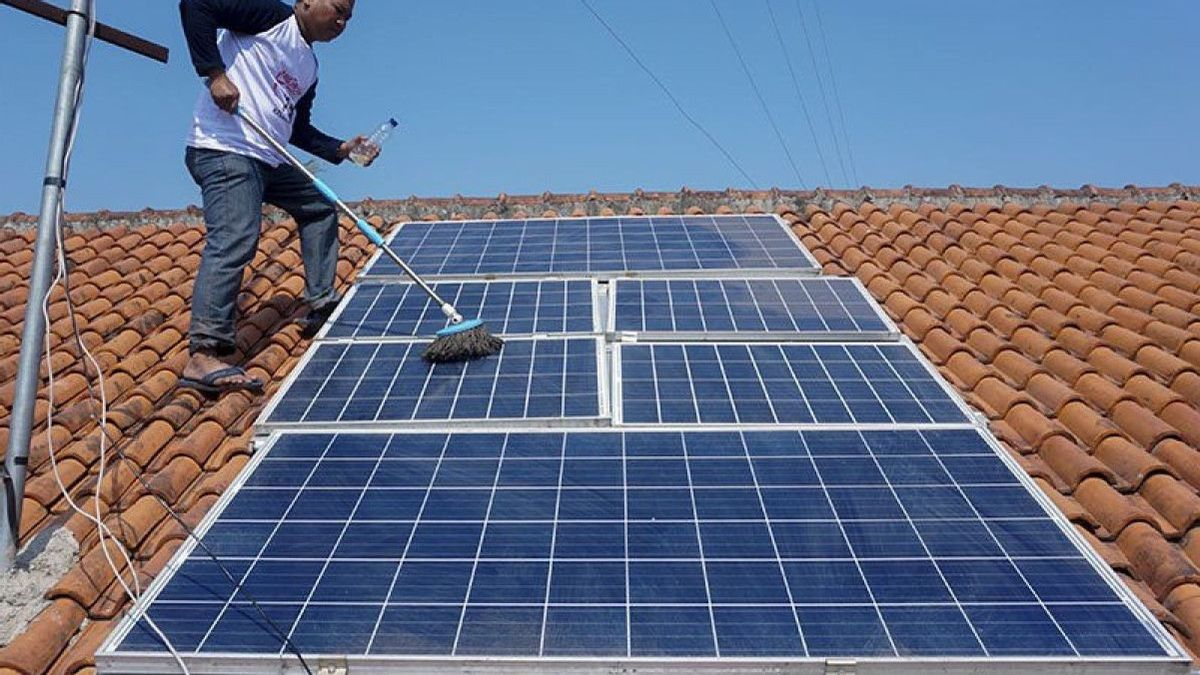JAKARTA - The Ministry of Energy and Mineral Resources (ESDM) officially issued a revision of the Regulation of the Minister of Energy and Mineral Resources Number 2 of 2024 concerning Rooftop PLTS Connected to the Electricity Network for Electric Power Supply Business Permits for Public Interest, which is a revision of the Minister of Energy and Mineral Resources Regulation Number 26 of 2021.
In this new regulation, the net-metering scheme is abolished so that excess electricity or electricity exports from users to PT PLN (Persero) cannot be calculated as part of the reduction of electricity bills.
This regulation also stipulates a roof PLTS system quota mechanism for the electricity system for the owner of the Electricity Supply Business License for Public Interest (IUPTLU) for five years.
In addition, this regulation stipulates a registration period 2 times a year and compensation given by the state to PLN if the basic cost of providing electricity is affected due to the penetration of roof PLTS.
Executive Director of the Institute for Essential Services Reform (IESR), Fabby Tumiwa, assessed that the elimination of the net-metering scheme will complicate the achievement of the National Strategic Project (PSN) target in the form of 3.6 GW PLTS roofs by 2025 and 23 percent renewable energy targets in the same year.
"The impact of the elimination of this scheme is the decline in the economic level of roof PLTS, especially in the household segment, which generally experiences a peak load at night," said Fabby and his statement to the media, Friday, February 23.
Fabby added that household or small business customers will tend to delay the adoption of roof PLTS because their electricity peak demand occurs at night, while PLTS generates a peak of energy during the day. Without net-metering, investment in roof PLTS becomes more expensive, especially if users have to spend additional funds for energy storage.
"Net-metering is actually an incentive for household customers to use the Rooftop PLTS. With the controlled PLN electricity tariff, net-metering helps improve the economic feasibility of the roof PLTS system installed at a minimum capacity, of 2 - 3 kWp for consumers in the R1 category," explained Fabby.
He continued, without net-metering and the cost of batteries which are still relatively expensive, this minimum capacity cannot be met so that the investment cost per kilowatt-peak unit becomes higher.
"This is what will reduce the economy of the roof PLTS system," continued Fabby.
For PLTS roof capacities greater than 3 MW (three megawatts), this Permen requires users to provide an integrated weather forecast database setting with the Supervisory Control and Data Acquisition (SCADA) system or a smart grid distribution owned by Electric Power Supply Business License holders for Public Interest (IUPTLU).
This regulation eliminates the obligation to pay parallel cost of power generation, namely capacity costs and emergency service costs that were previously applied to the industry - the equivalent of 5 hours per month. The elimination of these parallel costs adds to the appeal of industrial customers, but the obligation to provide a weather for systems of more than 3 MW will also add to the component of installation costs," said Marlistya Citraningrum, Manager of the Sustainable Energy Access Program, IESR.
Marlistya also highlighted the regulation of application submissions by prospective customers, which are carried out twice per year, namely every January and July.
SEE ALSO:
These arrangements and the determination of quotas per network system raise questions related to transparency in the determination and approval of quotas, especially for industrial customers who want to install roof PLTS on a large scale, while the IUPTLU mechanism to increase the quota when the system quota has run out is not clearly regulated in this regulation," he continued.
This regulation provides guarantees for customers who have utilized the roof PLTS system before this regulation is enacted, remain bound to the previous regulations, until the next 10 years. This includes still benefiting from the roof PLTS electricity export system.
"As an on-grid roof PLTS user, I actually have questions about this transitional rule - considering that during the installation, the export of roof PLTS is still calculated to be equivalent to 0.65 electricity rates based on the Minister of Energy and Mineral Resources No. 49/2018, not 1:1 like Permen ESDM No. 26/2021. This transitional rule needs to be clearly informed to current roof PLTS users," said Marlistya.
IESR also regrets that this Permen is too in favor of PLN's interests which can have an impact on hampering the participation of electricity consumers in supporting the government's goal of accelerating the energy transition in Indonesia, efforts to reduce GRK emissions that are low cost and not burdening the state because renewable energy investments are made by electricity consumers without the need for subsidies. state.
Fabby Tumiwa hopes that this new rule can be implemented by taking into account the benefits that the state gets if roof PLTS is allowed to grow rapidly, namely increasing renewable energy investment, growing PLTS industry, creating jobs, and reducing GHG emissions.
IESR urges evaluations after 1 year of implementing Permen to find out its effectiveness in encouraging the use of renewable energy in Indonesia. The government needs to openly revise it in 2025 in line with the declining threat of electricity overcapacity faced by PLN in Java-Bali.
The English, Chinese, Japanese, Arabic, and French versions are automatically generated by the AI. So there may still be inaccuracies in translating, please always see Indonesian as our main language. (system supported by DigitalSiber.id)













